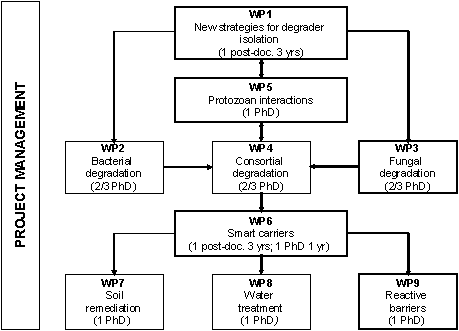 |
Work packages
This project is structured into 9 well-integrated work packages (WP), each headed by a WP leader. WP1 focuses on developing new strategies for isolating specific degradative bacteria and fungi. WP2 focuses on the ability of known and new degradative bacteria isolated within WP1 to remediate contaminated soil and water resources. WP3 is devoted to fungi and their ability to degrade otherwise recalcitrant pesticides. WP4 integrates the research of WP2 and WP3 to establish efficient inter-domain consortia for use in bioaugmentation of soil and water resources. WP5 deals with protozoa and their predation on the introduced microorganisms. Protozoa will also be delivered to WP1 to be used for isolation of bacterial and fungal strains resistant to predation. WP6 is devoted to developing carriers for strain immobilisation to enhance survival and activity of the strains in the field (soil, reactive barriers, or sand filters). WP7, WP8 and WP9 are all devoted to field-scale demonstrations of bioaugmentation technology. WP7 focuses on strategies for introduction of strains into soils, WP8 focuses on bioaugmentation of sand filters, and WP 9 focuses on development of reactive barriers within water supply wells to remediate contaminated groundwater prior to abstraction.

Figure 1: Scientific/technological structure of MIRESOWA showing the 9 Work Packages.
In the following description of the WPs the WP leader is indicated in bold type face.
WP1. New strategies for degrader isolation: A. Dechesne (post-doc) (DTU ENV), S. Rosendahl (DB/UC), S.R. Sørensen (GEUS), D. Springael (CUL): The aim of WP1 is to isolate new bacterial and fungal strains able to survive and degrade pesticides when introduced into the environment. We will develop methods to isolate oligotrophic strains that might hitherto have been overlooked. Furthermore, bacteria adapted to degradation of metabolites produced by fungi will be isolated with the aim of establishing fungal-bacterial consortia capable of degrading otherwise persistent pesticides. New strains will be delivered to WP2, WP3, and WP4 for further study.
WP2. Bacterial degradation: J. Aamand (GEUS), S.R. Sørensen (GEUS), D. Springael (CUL), and 2/3 PhD. As more efficient degradation is often obtained with mixed bacterial cultures than with single isolates, research on bacterial consortia will be emphasised. Soil and sand columns inoculated with the candidate strains will be prepared in the laboratory in order to study 1) their degradation efficiency, 2) their survival and sustained metabolic activity, and 3) the effects of environmental factors on degradation (e.g. starvation, availability of electron acceptors, and humidity).
WP3. Fungal degradation: S. Rosendahl (DB/UC), J. Aamand (GEUS), B.B. Kragelund (SPC/UC), and 2/3 PhD. Fungi probably play a much more important role in contaminant degradation than previously believed, and will therefore be investigated in detail. Fungi representing major taxonomic and functional groups (zygomycetes, both filamentous and yeasts, ascomycetes, and basidiomycetes) will be selected from our culture collection and, along with the new isolates obtained in WP1, will be screened for pesticide degradation potential.
WP4. Consortial degradation:J. Aamand (GEUS), S. Rosendahl (DB/UC), S.R. Sørensen (GEUS), and 2/3 PhD. Little is known about the breakdown of pesticides in fungal-bacterial consortia. The research will involve co-cultivation of the isolated fungal and bacterial strains or stable bacterial consortia. Some dilemmas will probably need to be resolved. For example, some bacteria may not degrade the pesticides in fungal media as the latter are usually rich in organic carbon either supplied to the medium as complex nutrient sources or secreted by the fungus as organic acids, enzymes, etc.
WP5. Protozoan interactions:F. Ekelund (UC), J. Aamand (GEUS), and 1 PhD. Protozoan grazing has been shown to lower the efficiency of bioaugmentation, but it is also known that protozoa prefer certain bacteria to others. Hence, some of the candidate strains might be grazed more intensively than other strains. WP5 will examine the extent to which candidate strains or consortia are grazed by various protozoa in lab-scale systems and whether immobilisation on carriers prevents grazing (WP6).
WP6. Smart carriers:S.R. Sørensen (GEUS), J. Aamand (GEUS), D. Springael (CUL), I. Weiergang (Danisco Seed), 1 post-doc (3 years) and 1 Belgian PhD (one year). WP6 will develop new second-generation carriers designed to meet known metabolic (e.g. nutrients or electron acceptors) and environmental (e.g. pH optima) requirements of the degradative strains.
WP7. Soil remediation: U. Gosewinkel Karlson (AU-NERI), J. Aamand (GEUS), S.R. Sørensen (GEUS), T.K. Bjerre (Odense Water), T. Korsgaard (Region of Southern Denmark), I. Edelgaard (DEPA), P.G. Pedersen (Danish Agency of Spatial and Environmental Planning), P.B. Nielsen (Krüger A/S), and 1 PhD. This WP is devoted to pilot- and field-scale bioaugmentation of soils contaminated with pesticides derived from point sources. If necessary, attempts will also be made to remediate the saturated zone close to the source of contamination. Many pesticides may bind strongly to soil particles or soil organic matter, thus rendering them less available for microbial degradation. The primary aim of this project is therefore to develop bioaugmentation technologies targeting bioavailable compounds leaching to the groundwater from contaminated sites.
WP8. Water treatment: J. Aamand (GEUS), H.-J. Albrechtsen (DTU ENV), A.-K. Pedersen (Copenhagen Energy); M.M. Juhl (Hvidovre Water), G. Tully (Svendborg Water), P.B. Nielsen (Krüger A/S) and 1 PhD. WP8 focuses on bioaugmentation of sand filters at waterworks to treat pesticide-contaminated drinking water. Preliminary results obtained using an artificial sand filter containing the BAM-degrading Aminobacter MSH1 indicate complete removal of BAM present in realistic, nanomolar concentrations. The first step will be to optimise this technology taking advantage of new strains (WP1) or consortia (WP4) and the developed carrier technology (WP6).
WP9. Reactive barriers: H.-J. Albrechtsen (DTU ENV), B.F. Smets (DTU ENV), W. Dejonghe (VITO), A.-K. Pedersen (Copenhagen Energy), M.M. Juhl (Hvidovre Water), G. Tully (Svendborg Water), T. Korsgaard (Region of Southern Denmark), P.B. Nielsen (Krüger A/S) and 1 PhD. WP9 focuses on existing abstraction wells. The fact that abstracted water passes through the well under controlled hydraulic conditions will be the basis for constructing reactive barriers with specific degradative strains able to prevent the contaminants from entering the waterworks. These barriers will be placed inside existing wells, thereby avoiding the need for expensive aquifer remediation.
|